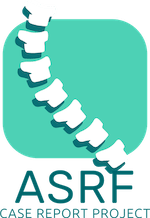November 2021 issue Asia Pacific Chiropractic Journal
apcj Issue 2.3 November 2021
Blum: A pocket review of clinical research for chiropractors
Ebrall: An introduction to autoethnography as a research methodology for chiropractic
Ebrall: A more inclusive evidence hierarchy for chiropractic
Leung & Chu: Hong Kong Chiropractic Survey: Analysis of Data.
Brown: Unexpected things that trigger anxiety [Patient handout]
Ierano: Gordon Binsmead: In Memoriam

Chiropractic management of a 30-year-old male with Motor Neurone Disease: A case report
Abstract
Objective/Clinical Features: A 30-year-old male presented for chiropractic care, with a diagnosis of Amyotrophic Lateral Sclerosis (ALS) type of Motor Neurone Disease (MND). He became symptomatic in 2017 and was diagnosed in March of 2019. At the time of presentation, he was newly diagnosed, receiving acupuncture, and was beginning to see a physiotherapist. His primary concern relative to the condition was emerging speech difficulty.
His initial consultation revealed balance difficulty, compromised Achilles and patella reflexes bilaterally and a positive Shimizu test along with muscle fasciculations noted in deltoids and triceps. The patient also had notable muscle wastage in the levator scapulae supraspinatus and tongue muscles.
Intervention/Outcomes: Predominant adjustments included Sacro-Occipital Technique (SOT) blocking, activator methods technique, shoulder mobilisation, TMJ adjustments and muscle releases, as well as wrist diversified adjustments, Talus traction pull, drop piece adjusting, and gentle diversified technique at approximately 10% of the normal strength used on an adult of that age and size. The focus was on the whole body due to the nature of disease.
Conclusion: This case suggests that subluxation-based, whole-of-body focused chiropractic care may contribute to successful management of ALS type Motor Neurone Disease.
Indexing terms: Amyotrophic Lateral Sclerosis, Motor Neurone Disease, Chiropractic Care, Subluxation, Speech difficulty, chiropractic, sacro-occipital technique, activator methods, cranial chiropractic care
Cite: Ullman E, Postlethwaite R, McIvor C. Chiropractic management of a 30-year-old male with Motor Neurone Disease: A case report. Asia-Pac Chiropr J. 2021;2.3. URL www.apcj.net/papers-issue-2-3/#UllmanALS
Schedule of Care
The Journal is providing the full schedule of care (with permissions of course). The express purpose is to demonstrate that decisions of frequency and duration of care are determined by the nature of the presenting case, the patient preferences, the practitioner’s judgements, and guided by the literature, which is sparse in this instance. F&D of care is far from an academic exercise determined by consensus as a ‘one size fits all’. This particular case is an excellent example of true ‘patient centred care’ with high patient compliance.
A pocket review of clinical research for chiropractors
Abstract: The purpose of this paper is to provide an easy-to-read yet comprehensive review of the place of case reports in chiropractic.
Terminology is given and explained to assist an understanding of ways to strengthen the act of a chiropractor recording a particular case in their practice for publication.
Indexing Terms: Chiropractic; case reports; research terminology.
Cite: Blum C. A pocket review of clinical research for chiropractors. Asia-Pac Chiropr J. 2021;2.2. URL www.apcj.net/papers-issue-2-3/#Blumoverview
A more inclusive evidence hierarchy for chiropractic
Abstract: The familiar evidence pyramid based on Sackett’s seminal work published in 1996 favours the reductionistic medical and pharmacological paradigms to the exclusion of the holistic chiropractic paradigm and patient-centred care.
Twenty-five years on, weaknesses and omissions are identified in the EBM approach and two disciplines (Nursing, Occupational Therapy) have re-defined a hierarchy of evidence and its understanding in their clinical environment.
This paper presents a fresh interpretation of Sackett’s premise, describing and depicting with argument that there is a more relevant way to assess evidence in the fields of chiropractic in general and subluxation in particular and that this approach reflects the clinical validity of Palmer’s major premise on which the profession is built.
The bottom line is that given the patient-centred nature of chiropractic which is mostly if not always an ‘N of 1’ encounter, the chiropractor is obliged to treat the patient and not a guideline. This new hierarchy (pyramid) allows the evidence to be gathered to better support the chiropractic encounter.
Indexing Terms: chiropractic; subluxation; evidence hierarchy; pyramid; spinal adjustment.
Cite: Ebrall P. A more inclusive evidence hierarchy for chiropractic. Asia-Pac Chiropr J. 2021;2.2. URL www.apcj.net/papers-issue-2-3/#EbrallEvidencehierarcy
An introduction to autoethnography as a research methodology for chiropractic
Abstract: Objective - To introduce the qualitative research method of autoethnography for the purpose of seeking a deeper meaning within the typical chiropractic doctor-patient encounter and to document those findings as a Chiropractic Autoethnographic Case Report.
Discussion - Autoethnography is the science of writing your lived experience. It is a valid scientific method of contextualising experiences in cultural, social, political and personal history. As such, autoethnographic writing is not analogous to autobiographical writing, the former is the application of a scientific method and the latter is more often than not, an indulgence.
Autoethnography is applied to report personal experiences in fields as diverse as anthropology, sports sciences, nursing and allied health care, design, creative art, political science and organisational management. Emerging in 1935 it was not until the mid 1990s that the method was applied within health care. This paper discusses autoethnography as a method to broaden the understanding of chiropractic by embracing philosophies of science beyond those of Post-Grecian Western methods, a necessary requirement given the intensifying multiculturalism of chiropractic expressed through Asian and Islamic lenses.
Conclusion - The common feature of all case reports is modulated for chiropractic: ‘well-written and transparent case reports (i) reveal early signals of potential benefits, harms, and information on [clinical methods and] the use of resources; (ii) provide information for clinical research and clinical practice guidelines, and (iii) inform [chiropractic] education.’ This paper commends the methods of autoethnography for exploration by ‘the chiropractor as expert’ of the experience of being an engaged participant in the phenomenon of chiropractic. This approach to inquiry may find a deeper level of meaning embedded in the chiropractic patient encounter.
Indexing Terms: chiropractic; autoethnography; epidemiology; phenomenology; research methods.
Cite: Ebrall P. An introduction to autoethnography as a research methodology for chiropractic. Asia-Pac Chiropr J. 2021;2.2. URL www.apcj.net/papers-issue-2-3/#EbrallAutoethnography
Hong Kong Chiropractic Survey: Analysis of Data.
Abstract: Objective -To summarize the key findings of the 2021 Survey of the Hong Kong Chiropractic Profession given to Hong Kong chiropractors and compare them to the practice patterns seen in similar local and international studies.
Method: A 52-question survey was conducted online, and access was provided via an email, Facebook, or WhatsApp invitation. The survey was sent to all registered chiropractors in Hong Kong and those on the database at the Chiropractic Doctors Association of Hong Kong, Hong Kong Chiropractic Association, and China Hong Kong Macau Chiropractic Association. The questions were divided into sections into the following areas: information about the typical chiropractic practitioner, chiropractic practice management, chiropractor beliefs, and chiropractor clinical management.
Summary: 80 chiropractors responded to the survey. The results indicate that the typical chiropractor in Hong Kong has a monthly income of $150,000-$300,000 HKD (19,230-38,460USD/month) and is an employee or sole practitioner with a thriving practice. Findings also suggest that the majority of chiropractors in Hong Kong have a vertebral subluxation focus and use a range of techniques in their practice.
Indexing Terms: chiropractic; Hong Kong; survey; practitioner income; practitioner beliefs.
Cite: Leung K, Chu ECP. 2021 Hong Kong Chiropractic Survey: Analysis of Data. Asia-Pac Chiropr J. 2021;2.3. URL apcj.net/papers-issue-2-3/#LeungChuHongKong
Unexpected things that could be triggering your anxiety
Patient Handout
Abstract: If you’re dealing with anxiety, you may be familiar with the common factors that can affect your anxiety. However, it doesn’t stop there. There are a few surprising things that can make you anxious, and it’s essential that you know how to identify them. Once you know what they are, it makes it much easier for you to manage them.
Indexing Terms: chiropractic; anxiety; mental health; well-being.
Cite: Brown D. Unexpected things that could be triggering your anxiety. Asia-Pac Chiropr J. 2021;2.3. URL www.apcj.net/papers-issue-2-3/#BrownAnxiety
Vale piano man. Gordon Brinsmead [In Memoriam]
Gordon Brinsmead was a 1960s Palmer College graduate whom I had known since 1984, when I was 20. He was one of my first chiropractors and, along with Alan Wigg, an early mentor. He died on 9 October, 2021 aged 84 while crossing the road at the mercy of a hit and run driver who was later apprehended.
Cite: Ierano J. Vale piano man. Gordon Brinsmead [In Memoriam]. Asia-Pac Chiropr J. 2021;2.2. URL Asia-Pac Chiropr J. 2021;2.2. URL www.apcj.net/papers-issue-2-3/#IeranoGordon











